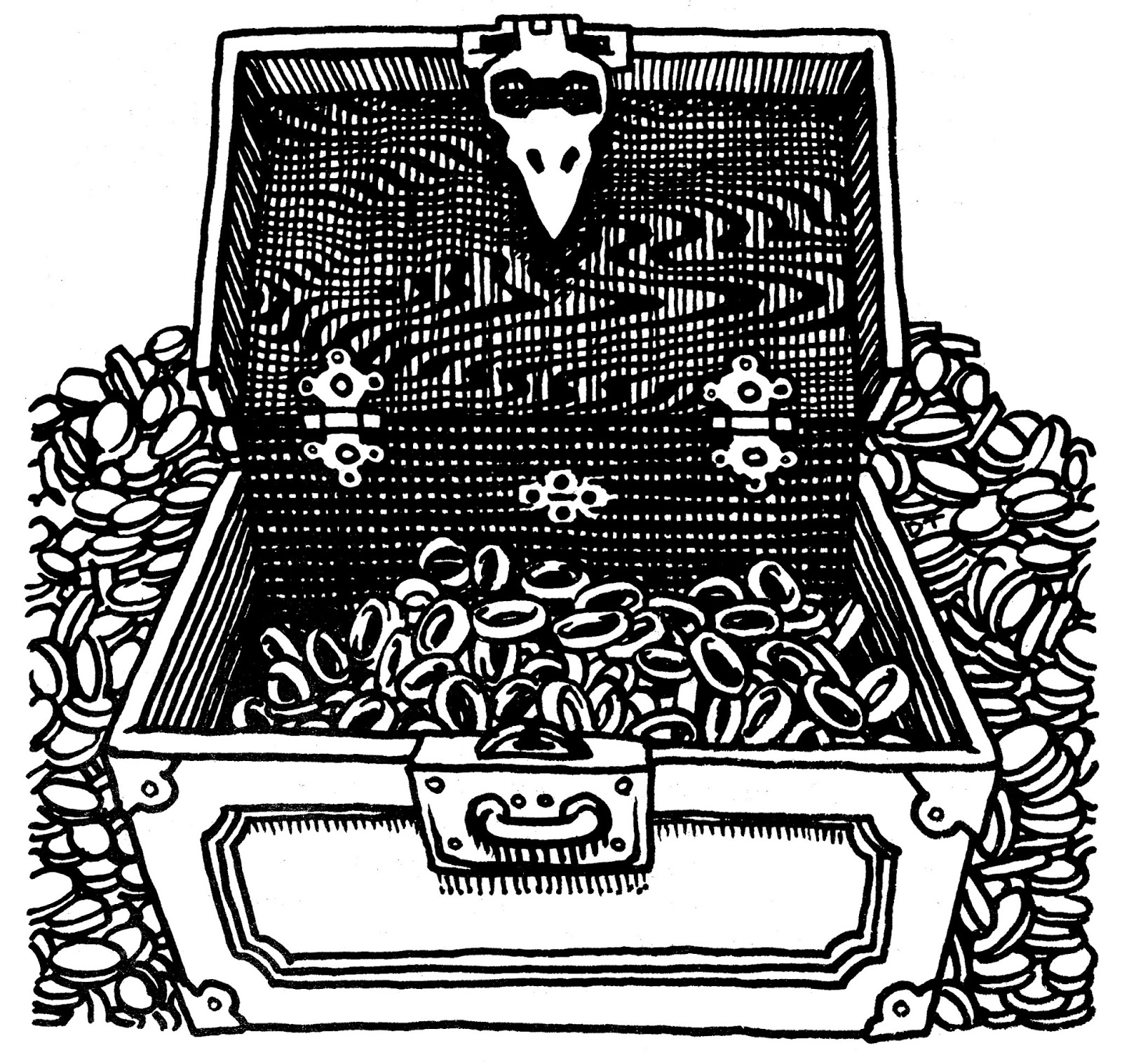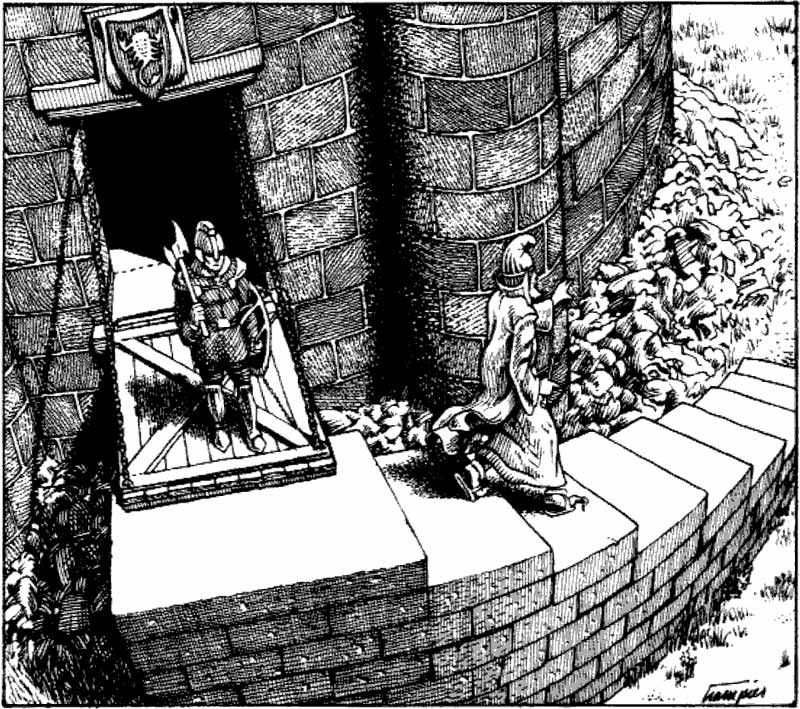

For convenience, dungeon exploration is divided into ‘turns’, each equivalent to approximately 10 minutes of real time. Each character may generally undertake one action during any given turn, including (but not limited to) movement, searching for traps/secret doors/treasure etc., interacting with a dungeon feature, and so on.
It is best not to be too leisurely while exploring as, in addition to the character’s light sources being used up, periodically the referee will be rolling for random monster encounters. By default this equates to a 1 in 6 chance of an encounter every second turn, but some areas may be more dangerous (or some less so!).
There are two basic kinds of movement: while mapping, in which the contours of the dungeon are measured by the characters and translated into a real world map for future player reference, and free exploration, in which the characters move at significantly faster rates in exchange for a significant loss in descriptive fidelity from the referee.
While mapping, each turn the party may move up to the slowest
character’s movement rate x20 in feet (ie. a party including a heavily
encumbered character, with a movement rate of 6”, moves up to 120’ in a
single exploration turn) [Holmes].
(Note that the referee may need
to be reminded of this rate periodically as he is used to the AD&D
rule which is only half as fast).
During free exploration the rate of movement described above is quadrupled [Delving Deeper] (ie. the slowest character’s movement rate x80 – the same heavily encumbered character would therefore move 480’ in a turn). In this case, the referee is no longer required to describe things using cardinal directions, provide precise measurements, etc., and nor will the players be permitted to annotate their map(s).
Doors are the most commonly encountered dungeon hazard, and are usually found stuck in their frames. The character attempting to open the door must check to see if the door is easily openable; this is usually a 2 in 6 chance but depends on the character’s Strength statistic. If so, the door may be opened easily and silently. Note that this check is made each time the characters attempt to pass through it, regardless if the check has been made already this adventure.
If a door is found to be stuck, further attempts may be made to force the door at the cost of time (1 turn) and noise – the referee will make an immediate wandering monster check for each individual subsequent check. Naturally any creatures on the other side of the door will be impossible to surprise!
Tools (crowbars, axes, etc.) may be used to force the door. This gives a +1 chance to open the door (ie. the default 2-in-6 chance becomes 3-in-6) but is always noisy and so provokes a wandering monster check.
Doors may also be spiked shut, or open if easy access is desirable, using the ubiquitous iron spikes. Any given spike has a 1-in-6 chance of having fallen out/been removed by a passing creature etc. [Houserule] if the characters have left the vicinity of that door.
Monsters are always able to open unspiked doors easily and silently.
Doors, and other appropriate dungeon features, can also be listened at. A character will always hear noise on the other side, but only have a 2-in-6 chance of positively identifying that noise. Compare eg. ‘someone behind the door is having an argument’ vs. ‘you hear three distinct voices, speaking Orcish, bickering about which is the best Star Wars film.’
A nonspecific search may be attempted by specifying a 10’x10’ area, taking one turn. Any character attempting such a generalised survey has a 2-in-6 chance of spotting anything out of the ordinary within the defined confines of the search. This needn’t be any more detailed than eg. ‘you find the outline of a secret door’.
It is generally better to look for specific things while searching as this will allow you to cover a wider area and receive more specific information about what you have found.
Traps have a 2-in-6 chance of being triggered if a character passes through or over them, rolled individually for each character potentially affected. This represents the chance of stepping over a pressure plate or tripwire etc. and does not apply to traps with unusually large or sensitive trigger mechanisms, or traps with which the characters are interacting directly.
Fleeing from hostile monsters can always be attempted, but many will persevere in their attempts on the character’s lives. Additional actions may be used to thwart such a pursuit – their chance of success depends on the relative intelligence of the creatures involved (‘intelligent’ here refers to creatures of approximately human capacity for thought). [7VoZ]
| Action | Intelligent | Semi-Intelligent | Unintelligent |
|---|---|---|---|
| Party increases lead to 100’ or more | 3-in-6 | 4-in-6 | 5-in-6 |
| Pursuers must guess passage (at T-junction
or similar), characters pass through normal door or take stairway etc. etc. |
2-in-6 | 3-in-6 | 4-in-6 |
| Characters pass through secret door | 5-in-6 | 5-in-6 | 5-in-6 |
| Burning oil on floor | 1-in-6 | 2-in-6 | 3-in-6 |
| Edible items left behind | N/A | 3-in-6 | 5-in-6 |
| Treasure left behind (presuming generosity!) |
5-in-6 | 1-in-6 | N/A |
Note that more motivated creatures may have their chances of continuing pursuit modified at the referee’s discretion.

FORTHCOMING